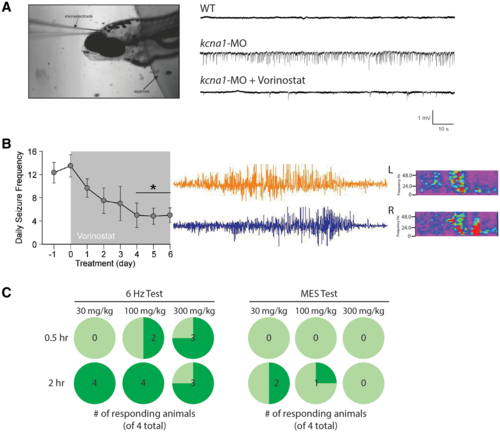Fig. 6
- ID
- ZDB-FIG-190617-9
- Publication
- Ibhazehiebo et al., 2018 - A novel metabolism-based phenotypic drug discovery platform in zebrafish uncovers HDACs 1 and 3 as a potential combined anti-seizure drug target
- Other Figures
- All Figure Page
- Back to All Figure Page
|
Vorinostat blocks seizures in zebrafish and rodents. (A) Image shows agarose-embedded zebrafish and the placement of a glass microelectrode in the tectum opticum. Representative extracellular field recordings obtained from the optic tectum of 6 dpf wild-type and kcna1-MO zebrafish larvae ± vorinostat treatment (40 μM). The presence of repetitive high frequency, large amplitude spikes indicative of hyperexcitability in knockdown animals is shown, and is abolished in the presence of vorinostat. (B) Representative electrographic seizure and heat maps recorded in Kcna1-null mice. Bar graph of the mean number of seizures per day recorded from six Kcna1-null mice ± vorinostat treatment. Mice were recorded for 24 h per day for 1 day, and then received vorinostat injection (40 mg/kg body weight/day) for 6 days. Vorinostat treatment significantly reduced the number of seizures (two-way ANOVA, F = 27.7, P < 0.01). (C) Acute (30 min dosing regimen) vorinostat (100 and 300 mg/kg) administration significantly reduced corneal electrode-stimulated seizures by 50 and 75%, respectively. A 2-h dosing regimen effectively reduced seizures across all concentrations used in the 6 Hz psychomotor test but not in the maximum electroshock test. |
| Fish: | |
|---|---|
| Conditions: | |
| Knockdown Reagents: | |
| Observed In: | |
| Stage: | Day 6 |

